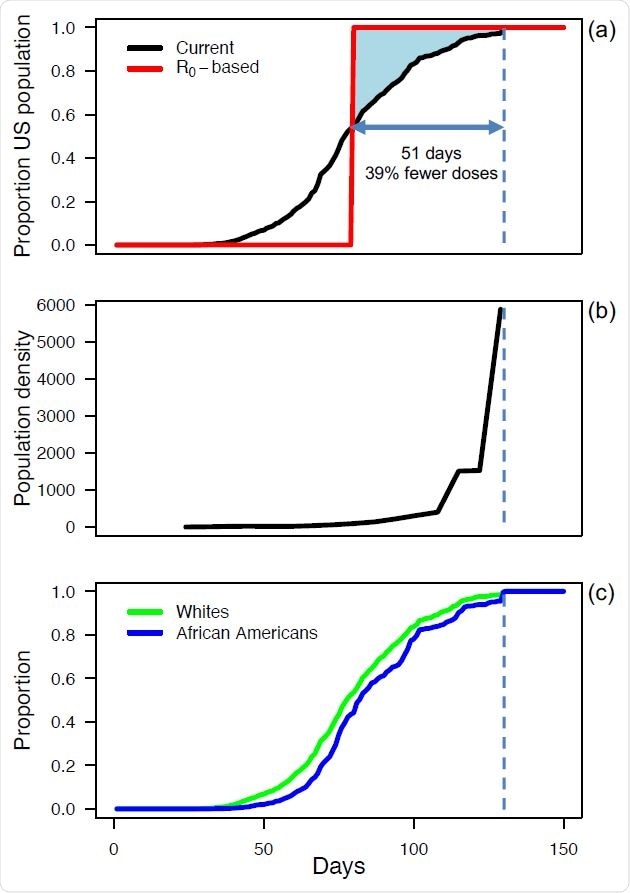The United States is a few days from reaching President Biden's goal of vaccinating 100 million people 100 days since he took office. While the United States leads the world in both the number of COVID-19 cases at over 29.7 million and deaths reaching past 539,000, it has stepped up as a leader in vaccinating its population.
However, the current vaccination strategy does not consider the basic reproduction number (R0), which helps to estimate the spread of COVID-19 cases.
A new preprint research paper published on the medRxiv* server by Anthony R. Ives from the University of Wisconsin-Madison and Claudio Bozzuto from the Wildlife Analysis GmbH suggests current vaccination efforts will have the United States reach herd immunity in about 4.5 months. However, they argue a more cost-effective and more effective vaccine strategy that takes geography into account. This would help allocate vaccines for high population counties that tend to be lower-class and with a high minority population. These counties are presently on track to be the last ones to reach herd immunity under the current vaccine distribution strategy.
The authors write:
"From an epidemiological perspective, because differences in R0 values among counties are partly driven by their population density, counties with the highest risk of resurgent and severe outbreaks are last at reaching herd immunity. From a socio-economic perspective, these high-density counties include many of those that are economic engines in the USA. Finally, high-density counties have relatively large African American populations, and the current distribution plan leads to a lag of about 4 days behind whites in reaching herd immunity."
Proposed vaccination strategy targets counties with high R0 numbers
Given that urban environments are at high risk of spreading the virus, dense populations produce a higher estimate of R0. Therefore, the authors argue that vaccination strategies should target dense populations to reach herd immunity sooner and avoid more COVID-19 cases.
To calculate this, they tracked the proportion of U.S. populations that would reach herd immunity under the current distribution strategy. Starting from March 15, 2021, they assume the following: the current vaccination rate using either of the three FDA approved vaccines — Moderna, Pfizer-BioNTech, or Johnson & Johnson — would be 1.58 million doses per day when 71.1 million people are already vaccinated with at least one dose, vaccines are 90% effective, and people who are vaccinated cannot spread COVID-19.
Their results showed herd immunity in the United States could be reached in approximately 130 days.

A feasible and efficient allocation of SARS-Cov-2 vaccines according to R0. Panel (a) shows the proportion of the US population living in counties having reached herd immunity, computed as 1 – 1/R0 at the county level; day 0 on the x-axis is March 15, 2021. The black line assumes the current distribution in which vaccines are sent evenly to counties according to population size, and the red line assumes the distribution depends on estimated county-level R0 values. Panel (b) shows the average population density of counties (individuals per km2) that reach herd immunity in a weekly time window. Panel (c) gives the proportions of white and African American communities living in counties that have achieved herd immunity.

 *Important notice: medRxiv publishes preliminary scientific reports that are not peer-reviewed and, therefore, should not be regarded as conclusive, guide clinical practice/health-related behavior, or treated as established information.
*Important notice: medRxiv publishes preliminary scientific reports that are not peer-reviewed and, therefore, should not be regarded as conclusive, guide clinical practice/health-related behavior, or treated as established information.
New plan reaches herd immunity sooner in all counties
In contrast, their analysis suggests their proposed strategy would help the United States reach herd immunity around the same for all counties and 51 days sooner than the current vaccination strategy. In addition, the United States would ultimately use 39% fewer vaccines under the new plan.
"These results are contingent on the R0-based strategy starting mid-March; the overall benefits will expectedly shrink the longer the population size-based strategy is kept."
With new variants of concern from the United Kingdom, South Africa, and Brazil, the researchers note these estimates could change, and more vaccinations may be needed.
To account for the new variants' higher transmission rates, they adjusted their mathematical formula to include transmission 1.5 times higher than what was initially measured at the start of the pandemic in 2020.
The findings show that with the researchers' proposed strategy, the United States would reduce the time to reach herd immunity by 76 days and use up less than 35% of their vaccine doses.
The evidence confirms that increasing vaccination efforts in more populated counties would be fairer and more efficient, use up fewer vaccines in the long-run, and reach herd immunity faster.

 *Important notice: medRxiv publishes preliminary scientific reports that are not peer-reviewed and, therefore, should not be regarded as conclusive, guide clinical practice/health-related behavior, or treated as established information.
*Important notice: medRxiv publishes preliminary scientific reports that are not peer-reviewed and, therefore, should not be regarded as conclusive, guide clinical practice/health-related behavior, or treated as established information.